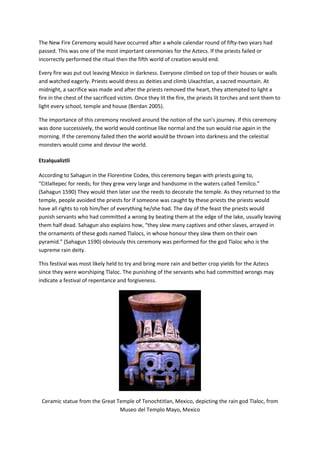Aztec religious rituals were performed to communicate with the gods and ensure favorable outcomes like rain and crop yields. Rituals had specific procedures and purposes, from pragmatic rituals meant to influence natural phenomena to commemorative rituals representing mythology. Ritual preparation involved fasting and an evening vigil of singing, dancing, and offerings. The important New Fire Ceremony occurred every 52 years to light new fires and ensure the sun's journey continued. Another key ritual was the Etzalqualiztli festival held for the rain god Tlaloc, which featured human sacrifice and punishing servants to bring rain and forgiveness.
![Aztec Religious Rituals
Aztec Rituals were a means of communicating with the gods by giving a gift that would hopefully be
repaid by the gods with a desired reward. Each ritual and ceremony has its own progression of tasks
that were meant to help them communicate to their gods. If they were not done in the right
manner, there could have been dire consequences.
Leonardo López Luján in “The Offerings Of The Templo Mayor of Tenochtitlan” (UNM Press, 2005),
lists several rites:
1. Pragmatic/Control: To influence natural phenomena
2.Commemorative: Mythical representation
3.Bereavement: Transformation of the dead into gods
4.Magical: Coercive and inherently effective in themselves
5.Religious: supplication and contingent
These five rites show the different purposes for different rituals. When the Aztecs sacrifice children
to Tlaloc, they are trying to influence natural phenomena of rain, making the ritual a Pragmatic rite.
Before a ritual or ceremony began, there was a fast that would last before the actual ceremony took
place. Usually, “The denial of food during fasting was ritually defined. Normally only one meal each
day, without chile and salt.” (Frances F. Berdan “The Aztecs of Central Mexico: An Imperial Society”
2005 2nd ed. Thomson-Wadsworth, Belmont, CA.)
The night before the ceremonies began a vigil was held. Berdan describes the events as: “[consisting]
of singing with musical accompaniment, dancing, and colourful processions. Offerings were a part of
virtually every ceremony, and ranged from incense and gifts (often food) to animals (usually quail)
and human beings for sacrifice.” (Berdan 2005). From this short description, we can see that each
ceremony had many parts. Each part was vital to the understanding of the ceremony.
The New Fire Ceremony
The New Fire Ceremony from the Codex Borbonicus and Codex Florentine](https://image.slidesharecdn.com/aztecreligiousrituals-120611205442-phpapp02/85/Aztec-Religious-Rituals-1-320.jpg)
